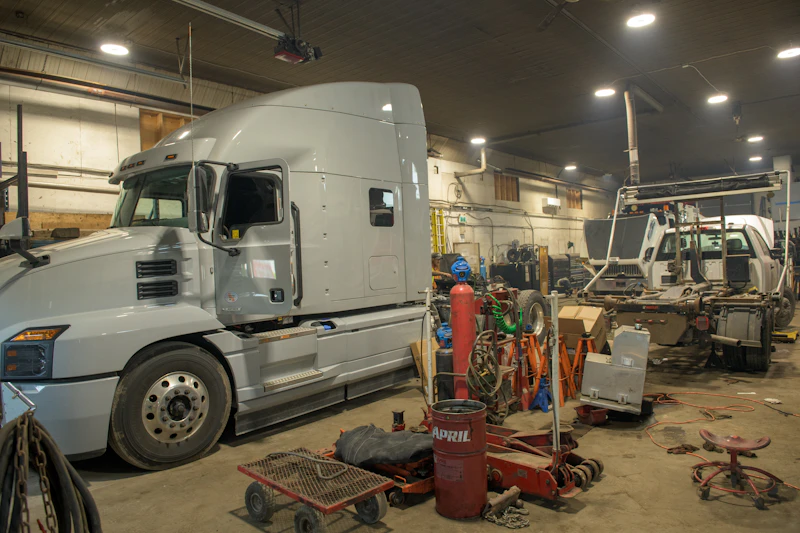Preventing Icing and Freezing of Heavy-Duty Truck Fuel Lines: Best Practices

It’s a cold winter morning. You get into your truck, ready for another day on the road. But what’s that sputtering noise, and why is your truck stalling? Frozen fuel lines.
It’s a scenario any driver or fleet manager can do without, which is why preventing icing and freezing in fuel lines is absolutely essential. Failure to do so is going to quickly put the brakes on your operations, risk safety on the road, and severely impact your bottom line.
Don’t worry, though; we’re here to help you survive the winter months with your fuel lines intact.
Understanding the Problem
To tackle this issue effectively, we must first understand how and why icing and freezing occur in heavy-duty truck fuel lines.
This problem occurs due to the sub-zero temperatures that diesel fuel operates in during the winter months. Diesel fuel contains paraffin, a waxy substance that solidifies in cold conditions. This paraffin wax forms crystals when the temperature drops, clogging the fuel lines and filters.
The consequences of frozen fuel lines are dire. Potential outcomes include extended downtime (potentially at the side of the road, which may require towing), expensive repairs, and safety hazards caused by fuel line failure. However, the worst of all is the irreparable damage to your reputation from missed deliveries.
Preventive Measures
Thankfully, several preventive measures can save truck drivers and fleet managers from such predicaments.
Anti-Gel Fuel Additives: These additives are specifically designed to inhibit the formation of wax crystals in diesel fuel. They alter the wax's molecular structure when added to the tank, preventing it from solidifying even at freezing temperatures.
Regular Maintenance and Inspections: Scheduled maintenance is key to identifying and addressing potential issues before they become critical. Regularly inspecting fuel lines, filters, and fuel tanks can help catch problems early on.
Fuel Type Selection: Choosing the right type of diesel fuel for colder climates can make a significant difference. Winter-grade diesel fuels are formulated to withstand lower temperatures without gelling.
Technological Solutions
Advancements in technology have provided even more robust solutions to combat fuel line freezing. These don’t just manage the consequences of fuel line freezing but actively prevent the cause in the first place.
Fuel Line Heaters: Electric fuel line heaters can be installed along the fuel lines to maintain a consistent temperature, preventing wax crystal formation.
Insulated Fuel Tanks: Insulated tanks help keep the fuel at a stable temperature, reducing the chances of wax crystallization.
Electronic Monitoring Systems: Modern trucks have electronic systems that monitor fuel conditions in real-time. They can alert drivers and fleet managers of potential issues, enabling timely intervention.
GPS-Based Route Optimization: Advanced route optimization software can help drivers avoid extremely cold regions or areas with a higher risk of fuel line freezing, reducing the need for extensive anti-freezing technologies.
Automated Thawing Systems: Some trucking companies employ automated thawing systems that can quickly thaw frozen fuel lines and get the vehicle back on the road, reducing downtime.
Remote Diagnostics and Maintenance: Utilizing telematics and remote monitoring systems, fleet managers can remotely diagnose fuel-related issues and schedule maintenance or fuel treatments as needed to prevent freezing.
Best Practices for Drivers and Fleet Managers
Now, let's get practical. Here are some best practices tailored for both drivers and fleet managers:
For Drivers
Keep the Fuel Tank Full: A fuller tank leaves less room for air and moisture, reducing the risk of condensation inside the tank, which can contribute to fuel line freezing.
Allow for Warm-Up Time: On cold mornings, give your truck a few extra minutes to warm up. This helps prevent sudden temperature shocks to the fuel system.
Carry Anti-Gel Additives: Always have a supply of anti-gel fuel additives on hand, especially during the winter months.
For Fleet Managers
Implement Training Programs: Train your drivers on cold weather driving practices and preventive measures. Knowledgeable drivers are your first line of defense against fuel line freezing.
Optimize Scheduling: During cold months, consider scheduling shorter routes or allowing more delivery time to account for potential delays due to weather-related issues.
Pre-Trip Inspections: Emphasize the importance of thorough pre-trip inspections, especially during the winter. Make sure drivers know how to check for any signs of potential fuel line problems.
Emergency Protocols: Develop clear protocols for drivers to follow in case of fuel line freezing or other cold-related incidents. Ensure they know how to use emergency kits and contact roadside assistance effectively.
Troubleshooting and Emergency Measures
Despite all preventive measures, there's always a chance of encountering fuel line freezing. If this happens, here's what you can do:
Thawing with Warmth: If your fuel lines freeze, the first step is to try to thaw them by parking the truck in a warm indoor area or using external heat sources.
Emergency Kits: Equip your truck with an emergency kit that includes portable heaters, anti-gel additives, and tools for loosening frozen fuel lines.
Contact Roadside Assistance: If all else fails, don't hesitate to contact roadside assistance. They have the expertise and equipment to deal with frozen fuel lines safely.
Remember, preparation is key. Having an emergency kit on board can mean the difference between a minor delay and a major breakdown.
Final Words
In the unforgiving world of heavy-duty trucking, preventing fuel line icing and freezing is not just a matter of convenience; it's a matter of survival.
By understanding the science behind the problem and implementing preventive measures and technological solutions, drivers and fleet managers can ensure smoother operations, reduced downtime, and enhanced safety, especially during cold winters.
Stay proactive, stay prepared, and keep the wheels turning even in the harshest of conditions. Your trucks, your drivers, and your bottom line will thank you.


.webp)
.webp)